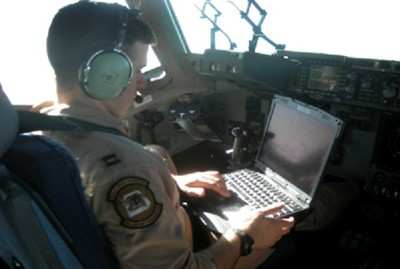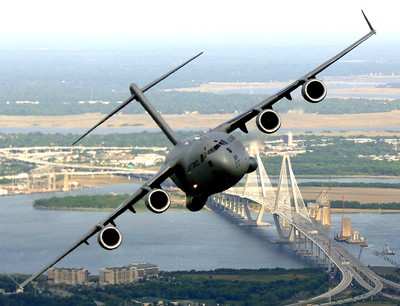Tue, Jul 12, 2011
Fuel Economies Of Up To 1.5 Percent Are Predicted
This summer, C-17 crews will start saving more gas by using
Mission Index Flying -- a new program that allows them to adjust
their flight profile in real-time in order to maximize fuel
efficiency while meeting mission objectives. The mobility air force
enterprise expects to see a 1.25 to 1.5 percent decrease in fuel
usage across the C-17 fleet, said Lt. Col. Marc Gildner, Air
Mobility Command Fuel Efficiency Office.

USAF Photo
"It doesn't seem like much. But because
Mobility Air Forces use almost 60 percent of the total Air Force
fuel inventory, that is a considerable dollar figure which can be
used to recapitalize the aging fleet, support fuel efficiency
initiatives and provide resources for incentives," Colonel Gildner
said.
Mission index flying was approved June 15 for use on the C-17
fleet, with aircrew training expected to be complete by the end of
the summer. The C-5 fleet is next, with fielding expected in late
July and aircrew training complete by early fall. The KC-10 and
KC-135 systems are being prepared for AMC testing and will be
fielded in the fall as well, Colonel Gildner said.

To use Mission Index Flying, air crews input various flight and
atmospheric parameters on a mission laptop at different intervals
during a mission, and the software provides them with speed and
altitude recommendations for maximum aircraft performance and
efficiency. While Mission Index Flying is new for AMC, it isn't a
new concept. Cost Index Flying (the commercial equivalent of
Mission Index Flying) has helped airlines manage bottom lines for
over a quarter of a century. "The airlines have realized increased
fuel efficiencies because they have been using this concept for
almost three decades," Colonel Gildner said. "We're trying to
capitalize and leverage their technologies and capabilities to our
benefit."
In the future, Mobility Air Force says it could use Mission
Index Flying to refine results for other efficiencies as well. Cost
Index Flying is used operationally by the commercial airline
industry to balance operational costs to fuel costs, Colonel
Gildner said. Operational costs include maintenance, labor,
over-flight fees, etc. These operational costs are examined to
determine their impact on overall flight costs per hour and then
balanced with fuel costs to provide the big picture, said Lt. Col
Eric Lepchenske, AMC Fuel Efficiency Office.
More News
Aero Linx: International Federation of Airworthiness (IFA) We aim to be the most internationally respected independent authority on the subject of Airworthiness. IFA uniquely combi>[...]
Ultrahigh Frequency (UHF) The frequency band between 300 and 3,000 MHz. The bank of radio frequencies used for military air/ground voice communications. In some instances this may >[...]
A Few Questions AND Answers To Help You Get MORE Out of ANN! 1) I forgot my password. How do I find it? 1) Easy... click here and give us your e-mail address--we'll send it to you >[...]
From 2019 (YouTube Edition): Learning To Paint Without Getting Any On Your Hands PPG's Aerospace Coatings Academy is a tool designed to teach everything one needs to know about all>[...]
Also: Sustainable Aircraft Test Put Aside, More Falcon 9 Ops, Wyoming ANG Rescue, Oreo Cookie Into Orbit Joby Aviation has reason to celebrate, recently completing its first full t>[...]
 ANN's Daily Aero-Linx (05.06.25)
ANN's Daily Aero-Linx (05.06.25) ANN's Daily Aero-Term (05.06.25): Ultrahigh Frequency (UHF)
ANN's Daily Aero-Term (05.06.25): Ultrahigh Frequency (UHF) ANN FAQ: Q&A 101
ANN FAQ: Q&A 101 Classic Aero-TV: Virtual Reality Painting--PPG Leverages Technology for Training
Classic Aero-TV: Virtual Reality Painting--PPG Leverages Technology for Training Airborne 05.02.25: Joby Crewed Milestone, Diamond Club, Canadian Pilot Insurance
Airborne 05.02.25: Joby Crewed Milestone, Diamond Club, Canadian Pilot Insurance




